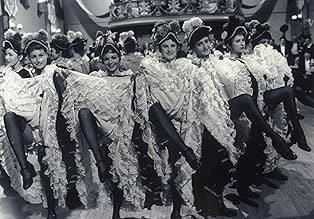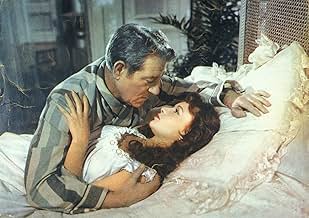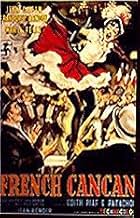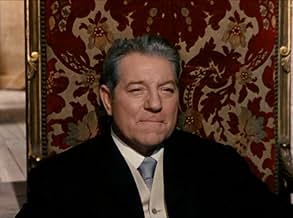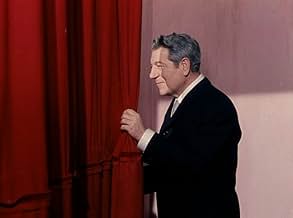French Cancan
- 1955
- Tous publics
- 1h 42min
NOTE IMDb
7,3/10
4,7 k
MA NOTE
Cette comédie dramatique de Jean Renoir relate la relance de la danse la plus célèbre de Paris, à travers l'histoire d'un directeur de théâtre qui transforme une humble lavandière en une ved... Tout lireCette comédie dramatique de Jean Renoir relate la relance de la danse la plus célèbre de Paris, à travers l'histoire d'un directeur de théâtre qui transforme une humble lavandière en une vedette du Moulin Rouge.Cette comédie dramatique de Jean Renoir relate la relance de la danse la plus célèbre de Paris, à travers l'histoire d'un directeur de théâtre qui transforme une humble lavandière en une vedette du Moulin Rouge.
- Réalisation
- Scénario
- Casting principal
Avis à la une
Acknowledgments to Cole Porter from whose lyric CanCan (the title song of his 1953 Broadway show of the same name) I take my one line summary. This is, purely and simply, a Valentine to Paris, the Belle Epoque, the Impressionists, you-name-it. As such it is both stunning and sumptuous.Gabin - who began in the French Music Halls - is superb, but then when isn't he, Arnoul is a revelation. More? Well, the photography is ... the music is ... the ambience is ... aw, what the hell, go see it, do yourself a great big favor. 9/10
The story is simple but the execution is marvelous. A Belle Epoque impresario, down on his financial luck, is going to open a new club, the Moulin Rouge, with a new dance, the French cancan. He encounters a working girl and makes her a dancer. She'll become a star. There are several crises to overcome before that happens.
The movie is Jean Renoir's tribute to show business, and he puts it on the screen with color, verve, humor, and humanity. There are wonderful performances by all the actors. The leads are Jean Gabin as Henri Danglard, the impresario; Francoise Arnoul as Nini, the girl who'll become a star; and Maria Felix as Lola de Castro, an overwhelmingly tempestuous beauty and Danglard's lover at the start. Gabin exudes confidence, worldly humor and dedication to show business. He even dances a bit. Arnoul is first rate, too. It looks like she was doing her own dances, and as an actress think of a young Leslie Caron with brains and charm.
The climax of the movie is the opening of the club, with Felix's star dance, comic songs, a whistler, a Danglar-discovered singer, all moving toward the introduction of the French cancan. The crises happen and are resolved. Then the cancan explodes. Dancing girls come bursting out from the stage, the front of the theater, through posters, down ropes from the balcony. The house swirls with the black tie and tails of the swells and the garish colors of the dancers' gowns. The cancan number lasts probably ten or fifteen minutes or so, all music and gaiety, all high kicks and splits. It's amazing when row after row of the dancers, moving toward the camera through the audience, leap up, legs extended straight forward and backward, backs arched, then land on the dance floor in full splits. I didn't know whether to shout or wince.
The last scene of the movie is outside the club, shot from the cobblestone street looking at the entrance. It's a medium shot and from the side street a happy, inebriated fellow in black tie and top hat staggers across, pauses to tip his hat at the camera, then staggers off. A completely charming ending.
This really is a marvelous movie.
The movie is Jean Renoir's tribute to show business, and he puts it on the screen with color, verve, humor, and humanity. There are wonderful performances by all the actors. The leads are Jean Gabin as Henri Danglard, the impresario; Francoise Arnoul as Nini, the girl who'll become a star; and Maria Felix as Lola de Castro, an overwhelmingly tempestuous beauty and Danglard's lover at the start. Gabin exudes confidence, worldly humor and dedication to show business. He even dances a bit. Arnoul is first rate, too. It looks like she was doing her own dances, and as an actress think of a young Leslie Caron with brains and charm.
The climax of the movie is the opening of the club, with Felix's star dance, comic songs, a whistler, a Danglar-discovered singer, all moving toward the introduction of the French cancan. The crises happen and are resolved. Then the cancan explodes. Dancing girls come bursting out from the stage, the front of the theater, through posters, down ropes from the balcony. The house swirls with the black tie and tails of the swells and the garish colors of the dancers' gowns. The cancan number lasts probably ten or fifteen minutes or so, all music and gaiety, all high kicks and splits. It's amazing when row after row of the dancers, moving toward the camera through the audience, leap up, legs extended straight forward and backward, backs arched, then land on the dance floor in full splits. I didn't know whether to shout or wince.
The last scene of the movie is outside the club, shot from the cobblestone street looking at the entrance. It's a medium shot and from the side street a happy, inebriated fellow in black tie and top hat staggers across, pauses to tip his hat at the camera, then staggers off. A completely charming ending.
This really is a marvelous movie.
I watched this movie three times at different ages of my life and always did enjoy it very much indeed. This Can-Can is an authentic explosion of joie de vivre, like Stanley Donen and Gene Kelly musical, but in French way. And a Jean Renoir nice tribute to his time, his friends, lovers, music and dances. It is at same time a show business chronicle of that age, full of affection and French mood. It is too a clear tribute to the Impressionism (people who likes impressionistic painters will like this picture). It is particularly a tribute to Toulouse-Lautrec and, of course, to Jean Renoir father, Pierre-Auguste. You will find hear a trustworthy and splendid colored recreation of some Renoir master work. Excellent casting, scenery, sound-effects and music. Even it tell us about the creation of Parisian Moulin Rouge, obviously it is a fiction story (and not very original by the way, as it fall down in the very well know moral that the show must go on). But the Jean Renoir production is great.
"French Cancan" is one of my favorite all time movies. It's an excellent film. There's color, there's humor, there's music. It's a very good portrait of the so called Belle Époque, though Jean Renoir's priorities were always to show a creation, a fantasie. So the film isn't a historical movie. The final sequences in which the girls dance cancan are unforgettable images. It's a film you shouldn't miss.
A charmingly amoral club owner sets his sights — amorous and financial — on a beautiful, naïve blue collar girl and propels her to the height of celebrity thanks to her titillating dance skills.
It may sound like a contemporary, cutting edge urban drama, but French Cancan was made in 1956 by famed director Jean Renoir. The movie — a darkish comedy with a progressive take on sexuality — chronicles the birth of the Moulin Rouge. Legendary Jean Gabin plays Danglard, a world-weary hustler, club owner and anti-hero for the ages, who makes no pretense of his philandering and amorous proclivities. He's casting about for a new lover and a new money making venture when his current club fails and he grows bored with his mistress. He discovers a beautiful young washer girl, Nini, whom he convinces to headline at his new "concept" club, the Moulin Rouge, making it a hot spot and her a celebrity before the doors even open.
It doesn't hurt that Nini's moody ex-lover — a sullen baker (le petit grump) — injures Danglard in a fight and an even moodier Russian count becomes suicidal because Nini spurns his advances. As the salacious headlines drive up public interest, they learn the club will feature the cancan in all it's thigh-revealing, petticoat-flashing, bawdy glory — a disreputable dance to begin with now fallen completely out of favor.
The movie is a riot with memorable characters, beautiful, dizzying club and dance scenes, a few titillating moments that must have pushed the limits 60 years ago and swooning French girls forever throwing themselves desperately into and out of the arms of their lovers. You almost forget that it's a musical, so seamlessly are the musical and dance scenes integrated into the plot.
Danglard's gangly side kick is hilarious as is the whistler. Most delightful of all was seeing and hearing the divine Edith Piaf on screen after listening in awe to her songs all these years.
The movie is best enjoyed with absinthe in honor of the absinthe consumed on screen — as fate would have it, we had some delightful Oregon-made absinthe that night — or lots of champagne.
-- www.cowboyandvampire.com --
It may sound like a contemporary, cutting edge urban drama, but French Cancan was made in 1956 by famed director Jean Renoir. The movie — a darkish comedy with a progressive take on sexuality — chronicles the birth of the Moulin Rouge. Legendary Jean Gabin plays Danglard, a world-weary hustler, club owner and anti-hero for the ages, who makes no pretense of his philandering and amorous proclivities. He's casting about for a new lover and a new money making venture when his current club fails and he grows bored with his mistress. He discovers a beautiful young washer girl, Nini, whom he convinces to headline at his new "concept" club, the Moulin Rouge, making it a hot spot and her a celebrity before the doors even open.
It doesn't hurt that Nini's moody ex-lover — a sullen baker (le petit grump) — injures Danglard in a fight and an even moodier Russian count becomes suicidal because Nini spurns his advances. As the salacious headlines drive up public interest, they learn the club will feature the cancan in all it's thigh-revealing, petticoat-flashing, bawdy glory — a disreputable dance to begin with now fallen completely out of favor.
The movie is a riot with memorable characters, beautiful, dizzying club and dance scenes, a few titillating moments that must have pushed the limits 60 years ago and swooning French girls forever throwing themselves desperately into and out of the arms of their lovers. You almost forget that it's a musical, so seamlessly are the musical and dance scenes integrated into the plot.
Danglard's gangly side kick is hilarious as is the whistler. Most delightful of all was seeing and hearing the divine Edith Piaf on screen after listening in awe to her songs all these years.
The movie is best enjoyed with absinthe in honor of the absinthe consumed on screen — as fate would have it, we had some delightful Oregon-made absinthe that night — or lots of champagne.
-- www.cowboyandvampire.com --
Le saviez-vous
- AnecdotesThe on-screen singer of "La complainte de la Butte" is not Cora Vaucaire (credited in the titles) as she was deemed not good-looking enough to appear on film, so Italian actress Anna Amendola was put in front of the camera and mimed to the song...
- Citations
Henri Danglard: Do I look like Prince Charming? Only one thing matters to me - what I create.
- Versions alternativesOriginally released in the US in 1956 at 93 minutes; ten minutes of footage removed from the original French version were reinstated for 1985 reissue.
- ConnexionsFeatured in Voyage à travers le cinéma français (2016)
Meilleurs choix
Connectez-vous pour évaluer et suivre la liste de favoris afin de recevoir des recommandations personnalisées
- How long is French Cancan?Alimenté par Alexa
Détails
Box-office
- Montant brut mondial
- 10 799 $US
- Durée1 heure 42 minutes
- Couleur
Contribuer à cette page
Suggérer une modification ou ajouter du contenu manquant

Lacune principale
By what name was French Cancan (1955) officially released in India in English?
Répondre
![Regarder Bande-annonce [VO]](https://m.media-amazon.com/images/M/MV5BMDIzNTViZDUtMTQ0MC00MDExLWFkNzYtNjJhMDlkN2YzMDRjXkEyXkFqcGdeQXRyYW5zY29kZS13b3JrZmxvdw@@._V1_QL75_UX500_CR0)
